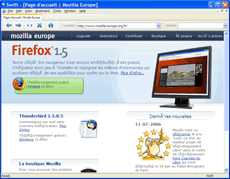Hello,
My name is Pascal Chevrel, among other things I am a Mozilla Europe board member and I have been blogging about Mozilla technologies for about 4 years in both French and Spanish. As you can see, I have decided to start blogging in English as well, so please excuse my French ;)
What kind of stuff can you expect to read here? Mostly web content localization news. My main task at Mozilla Europe is to coordinate the translation work so as to offer official Mozilla content in as many European languages as possible. We started with 4 languages more than 2 years ago and we now have a website offering content in 22 European languages. But not only do we host European languages, we also host via our mozilla-world alias the Firefox start pages for almost all Firefox languages (ex : http://www.mozilla-world.org/he/products/firefox/start/central.html).
So as to give you an idea, we have about 20 million visits per month and so far we are totalizing 1.6 billion hits for 2006. Quite a lot of traffic...
Actually, it also reflects the huge European success of Firefox and how language support matters for the success of the Mozilla project. People want Firefox and Thunderbird, but they want it in their language, computer geeks fluent in English may be happy with an English browser, but my mother won't even consider using a software that isn't in her language.
The Mozilla project was born at Netscape and then hosted by AOL. One of the reasons why AOL/Netscape, although a big corporation compared to Mozilla, failed getting back market-share with Netscape 7 is simple, it was usually available in 5 languages only (US-English, German, French, Japanese, Brasilian Portuguese) and you could wait months after the English realease before seeing the browser released in your language, sometimes, the localized build was available on the FTP but the official website only offered the English build or worse, a much older version. Furthermore, the quality of the translation wasn't always that good, at least for French... For Joe-user, Netscape was English-only, a showstopper for most of the global population.
Languages matter and it is one of the things the Mozilla project is good at. The quality of our software localisation is excellent and Firefox and Thunderbird are available in a great number of languages (currently 37) including several minor languages which are not even considered as a "market" by proprietary software vendors. If you look at Rafael Ebron's High Level Product Comparative Analysis between Internet Explorer 7 and Firefox 2, you see that IE7 will be released in 15 languages only which means that we definitely have a strong asset here since we already support 37 languages and we may even have more languages available in the future.
Mozilla Europe was created and is maintained by European volunteers because of that, because we believe that localisation is key to the success of Mozilla products, because we believe that the opensource model is a great solution for software localisation; for many people, it is even the only way to have software on their machine in their mother tongue...
Teaming up with Mozilla.com and Mozilla Japan, we will definitely use the expertise we gained managing a multilingual project over the last two years so as to provide more and better localized content for Firefox 2.
